Digital Transformation and the End of Competitive Advantage
How Can We Survive Disruptive Inflection Points in Business?
How can business leaders spot and deal with inflection points in their industries before it's too late?
As digital transformation disrupts industries, incumbent companies face growing uncertainties. How can executives read the signs of change in their industries and react in time to create opportunities?
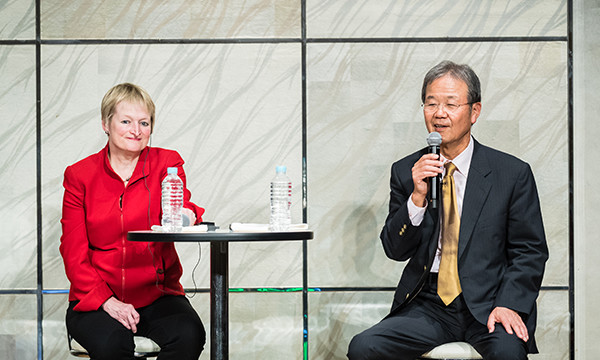
Fujitsu tackled these issues in its executive forum featuring "Digital Business Strategy – Inflection Point of Digital Transformation," held on Oct. 22, 2018, at the Cerulean Tower Tokyu Hotel, Tokyo. Two guest speakers were Rita McGrath, Professor at the Columbia Business School; and Yuzo Toda, who until recently was Chief Technology Officer and Vice President of Fujifilm Corporation, and who now serves as the Representative Director and Chairman of the Forum for Innovative Regenerative Medicine. The speaker from Fujitsu was Yoshikuni Takashige, Vice President of Marketing Strategy and Vision. In the second half of the event, Takashige, taking the role of moderator, led a lively panel discussion with McGrath and Toda.

Rita McGrath
Professor of management at the Columbia Business School. Globally recognized as a premiere thought leader on innovation and growth under uncertainty.
Received the No. 1 achievement award in Strategy from the prestigious management rankings group Thinkers50 and has been consistently named one of the world's top 10 management thinkers.
Recently published a global best-selling book, The End of Competitive Advantage.
Provides strategic consulting to the world's leading companies and is a sought-after speaker at executive events.

Yuzo Toda
Representative Director and Chairman of the Forum for Innovative Regenerative Medicine. Former Chief Technology Officer and Vice President of Fujifilm Corporation.
Joined Fujifilm in 1973. Engaged in product development and manufacturing technology, and led several innovative projects and ventures, including cosmetic, supplement and pharmaceutical businesses, before leaving the company in June 2018.
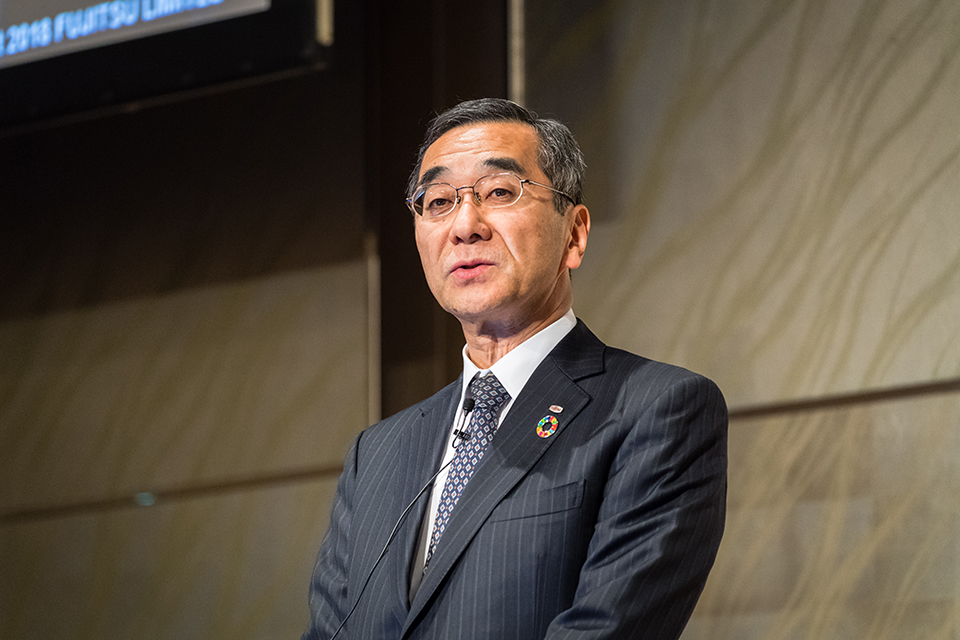
Nobuhiko Sasaki, Corporate Executive Vice Chairman of Fujitsu, opened the event. During his opening remarks, he stated that companies today "need to forge strategies for the digital age and execute them in a timely manner," wishing the discussions in this forum would help corporate senior executives to take away key insights for that.
Inflection Points from Digital Transformation
 Rita McGrath
Rita McGrath
Digital transformation triggers inflection points that disrupt traditional business and end existing competitive advantages.
In this fast-changing world, a company's competitive advantage has a lifecycle that begins with innovation, scales up with production and can then be quickly exploited for revenue. So it is a "transient competitive advantage," and it is important for companies to detect impending inflection points of digital transformation in their industries, then devise strategies to deal with the disruption that is sure to follow.
Otherwise, they risk being relegated to the sidelines as their competitors take the initiative. You can't avoid this. You're either going to transform your business with digital technologies, or you're going to see someone else do it.
Watch the video to find out the key points of "Digital Transformation Infection ①" from Prof. McGrath.
The digital transformation made possible what was once impossible. For example, if a company or individual wanted to get a message out to 2 billion people 20 years ago, they would have had to own a media empire. But today, with social media, such as Facebook, you can conceivably get the message out to one-third of the total world population.
As digital technologies are thus changing the nature of what is possible, companies need a new way to think about strategy.
Changing Nature of Competition
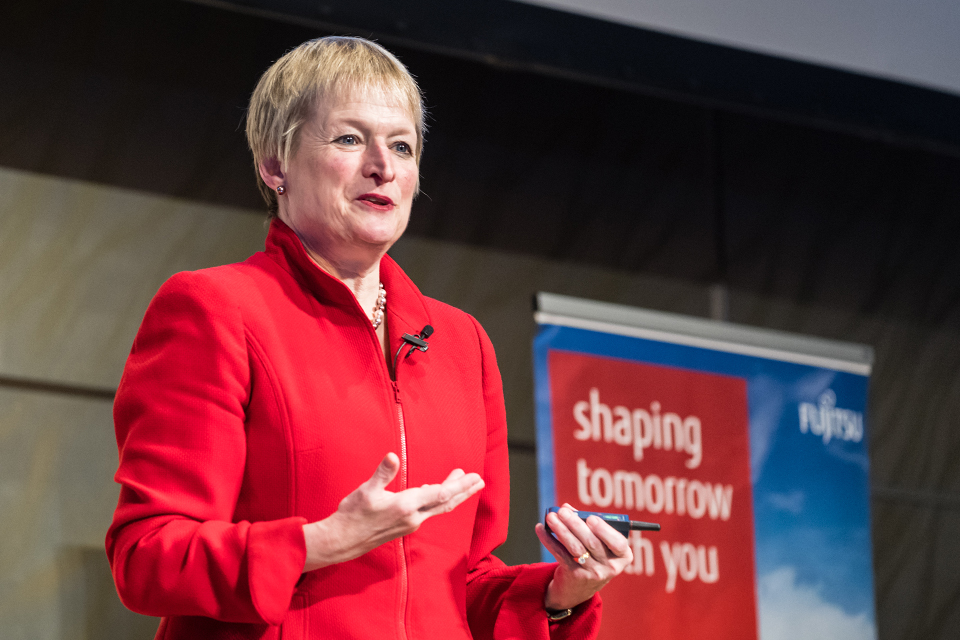
Strategic inflection points also mark the changing nature of competition. In a conventional sense, competition happens within industries. For example, an automaker would say that its competitor is another automaker. But in the digital era, outside players are going to enter the market as strong competitors. Competition is also shifting to "arenas," which is the new marketplace where a range of companies from different industries compete to help customers achieve their goals.
Take a look at a graph depicting changes in household spending in the several years after the first iPhones were released in 2007. According to a study from the Wall Street Journal, spending on such things as clothing and major appliances dropped, while the two biggest growth areas were internet service to the home and cellular phones.
Arenas, not industries
Let's say you're a clothing maker. Competition is not just with other clothing makers but also with smart phones and internet services.
How might you have responded to an inflection point if you were, in fact, in the business of making clothing? To answer this question, you need to look at clothing not as a product but at what "job to be done" it does for customers, a concept developed by Clayton Christensen Essentially, we don't buy products and services, we "hire" them to get jobs done in our lives.
With teenagers, for example, the main job clothing does is to communicate who they are, to signal their belonging to a particular group. We may say that the message of clothing for teenagers has become more important since the advent of social media.
Now, everybody's on the phone; everybody's on Facebook or the equivalent; they're sending pictures to each other. And if you've got the same outfit on in picture after picture, how lame is that? What you want is to look different all the time. And clothing now is almost the minute-by-minute representation of who you are to your friends in this digital world.
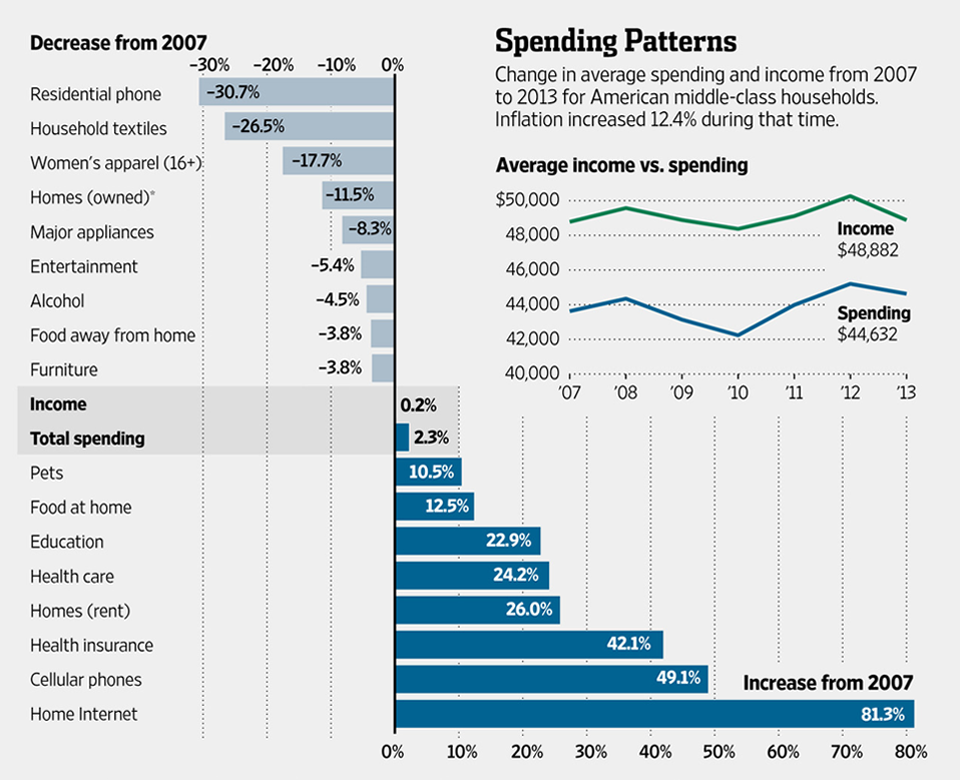 Graph depicting changes in household spending in US
Graph depicting changes in household spending in US
Note: Data includes middle 60% of Americans by income, not adjusted for inflation.
*Reflects annual cost of home ownership excluding principal payments and capital investment.
Source: Bureau of Labor Statistics Consumer Expeniture Survey The Wall Street Journal
But the business model of many traditional clothing manufacturers, which roll out new designs only four times a year, doesn't work for teenagers who want fashion that is continually refreshed. Traditional clothing merchants, such as department stores, have seen consistent drops in their sales targeting teenagers. They didn't see the change coming. If they were thinking ahead about the inflection points, and what the job is that their product is really doing, they could have anticipated it. They could have been much more creative and open to changes.
By contrast, clothing makers and retailers that have embraced this change, such as Inditex Group's Zara, Uniqlo, Forever 21 and H&M, have done well. And even they are being threatened by even faster-fashion brands that manufacture in very rapid cycles.
Digital Transformation in the Steel Industry
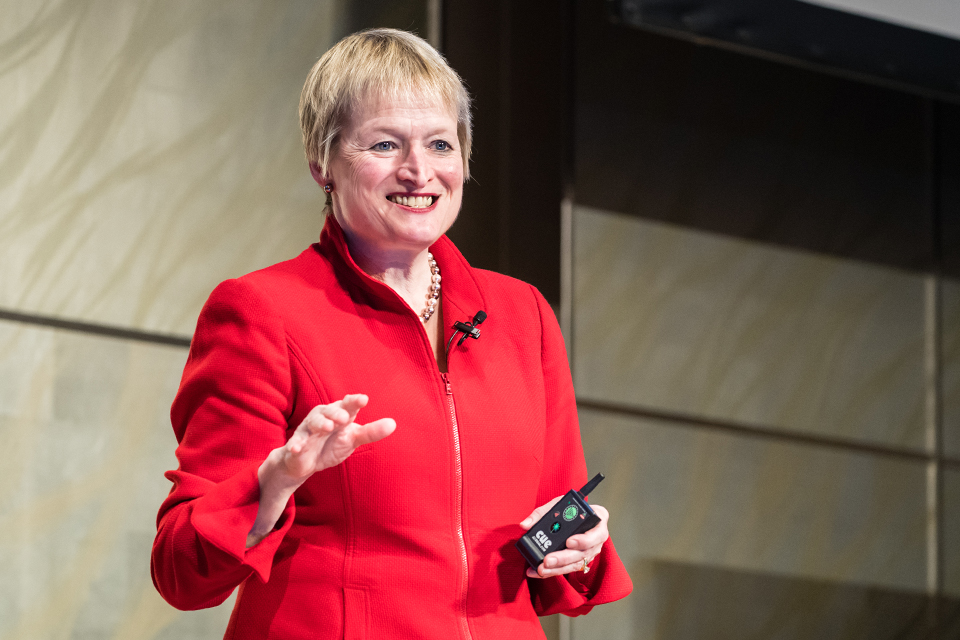
A successful example of creating new "arenas" is large German steel industry distributor and middleman Klöckner & Co. The more than 100-year-old company has gone full-scale into digital transformation.
While the production side of the industry is dominated by large steel manufacturers, the industry space that Klöckner inhabits is very fragmented and crowded with a lot of small to mid-sized companies. And the entire supply chain has a problem.
Customers have a lot of demands for immediate gratification, so one of the consequences is that there's excess inventory at all parts of the supply chain.
Klöckner CEO Gisbert Rühl feared that if the steel industry didn't reform, it would be vulnerable to the same kinds of disruptions that have happened in other industries. Digital platforms, such as Amazon, Uber and Airbnb transformed many other industries. Maybe steel was next.
Rühl decided he needed to go farther outside of the company's Western German headquarters to Berlin, sort of the Silicon Valley of Germany. He hired two engineers and told them: "Go to Berlin and be part of the ecosystem. See what people are doing with digital and start our own business."
The company launched a start-up, separate from but working with, the parent company. Over time, the digital start-up got larger. It trained employees from the parent company. Its main strategy involved building a digital platform–actually two platforms. One was proprietary to Klöckner, making it easier for customers to do business with the company. The other was opened to the industry to support all the participants.
Klöckner went live with the first version of its open industry platform, "XOM METALS", in February 2018. The company notes that XOM is separate from Klöckner's online shops, and plans call for XOM to be a completely independent digital marketplace, ultimately funded by outside investors. While it still remains to be seen whether the rest of the industry will participate in the XOM platform, Rühl believes it will.
Signals of Coming Change
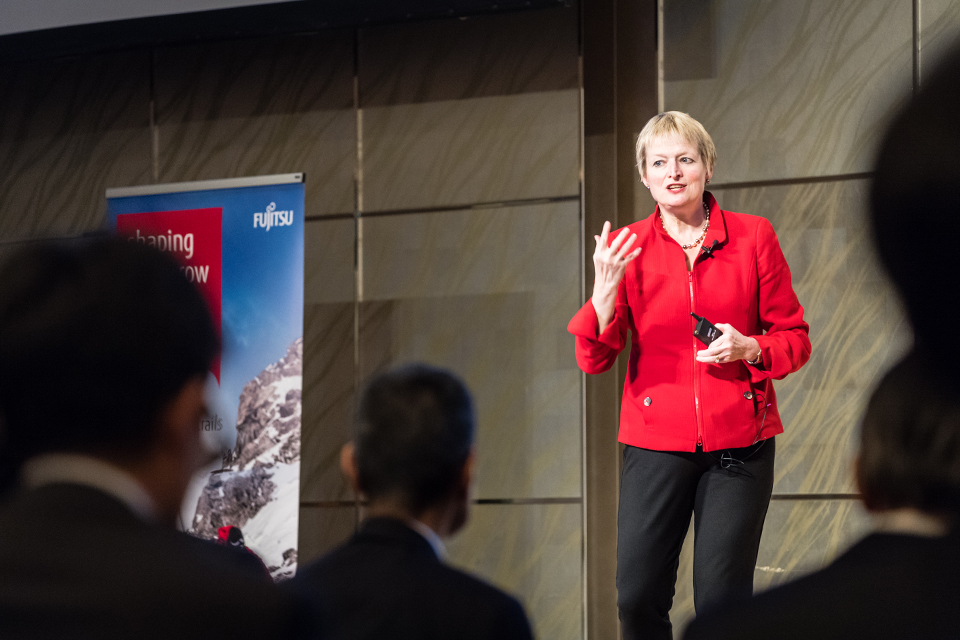
How do corporate leaders become able to identify the signals of an inflection point about to happen? One way is to follow the advice of semiconductor industry pioneer and Intel co-founder Andy Grove, whose book, Only the Paranoid Survive, noted that, to see an inflection point brewing, learn from nature. In nature, when spring is coming, the snow will melt first on the periphery. So do inflection points and a fully different landscape appears at a certain moment.
The following is a practical checklist for companies to use to try to spot digital inflections:
Watch the video to find out the key points of "Digital Transformation Infection ②" from Prof. McGrath.
Do I have mechanisms to come in direct contact with the 'edges'?
Facebook is an example of a company that is headed for trouble for not observing this principle. The social media giant has been hit by scandals for breaching its users' trust. Moreover, the two founders of Instagram, which Facebook bought in 2012, have left. Instead of innovating as they once did, Facebook is now becoming kind of defensive.
Am I regularly gaining exposure to diverse perspectives?
For example, entrepreneurs who set up free internet kiosks targeting tourists in spaces that used to be taken up by public telephones in New York City neglected to adequately consult with people who know what is really happening on the streets of New York City, and so the project had to be completely rethought.
Am I trusting and empowering small, agile teams?
This is an idea followed by Amazon founder and CEO Jeff Bezos, who grants more freedom to small, empowered teams to experiment and to make decisions as long as they do not require big commitments of resources.
Do I have mechanisms for fostering 'little bets'?
For example, Adobe has a system called a Kickbox, which is literally a red box. What's inside the box are a candy bar, a Starbucks card and a $1,000 gift card. What will one do with it? He or she can spend the money any way they want to test an idea. Observing results, the company could identify ideas that are most likely to produce the next opportunity.
Do I regularly get out of the building to see what's going on?
At the Gap clothing store chain, executives regularly visited a store, and the forthcoming visits caused the store staff to work overtime in order to get the place ready, showing it to look more tidy than usual. Naturally, the executives were not able to see what was really going on at the store. But that is what they should see. You need to make it a business habit to go and see what is really going on.
Are incentives aligned with gaining uncomfortable news?
News of an inflection point doesn't land at headquarters at the conference table. News of an inflection point starts out with the strange question a customer asked, with an unusual request somebody made, with something coming on the radar that doesn't fit. Executives have to have an internal mechanism to access such uncomfortable news.
Am I making sure I'm not in denial?
Denying a negative sign or an uncomfortable reality often leads to poor results in business. It makes management blind to inflection points and to react too late to take corrective action.
We can't be defensive to keep things the same anymore. We need to be thinking about offense, being proactive, taking the next step.
Business Strategy in the Digital Age
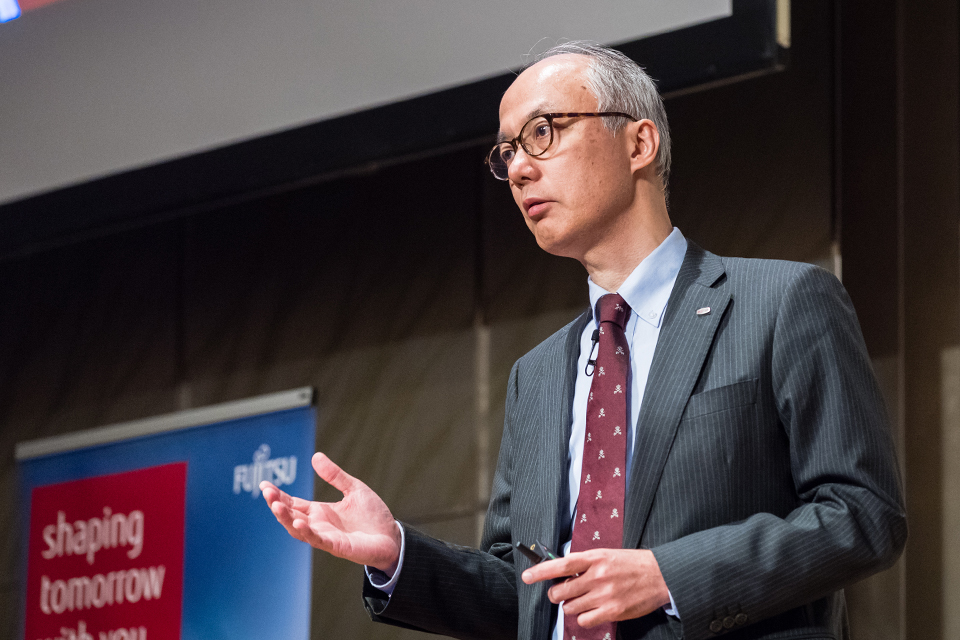 Yoshikuni Takashige
Yoshikuni Takashige
What does "digital" mean? I think it addresses the digitalization of everything happening all around us -- information from business operations to human genes. How to create value from such variety of data has become a big business priority. In this age of data, however, many business leaders in the world have started to look at a business model placing people at the center.
Fujitsu has long been emphasizing our human-centric vision. It simply means putting people at the center of everything to create value. This vision becomes critically important for all kinds of businesses in this digital age.
Watch the video to find out the key points of "Business Strategy in the Digital Age" from Takashige.
For example, auto OEMs have been taking a product-out style of business model to compete in delivering better cars. But today, what people truly want is not a product in the form of a car. They are looking for value of mobility experience, enabling the most comfortable and most efficient transportation from point A to point B. It is exactly what Professor McGrath called the "job to be done" of customers.
Such human-centric value of mobility can be co-created by putting people at the center of an emerging ecosystem, comprising auto OEMs, component suppliers, digital service providers, utilities, insurance companies and many others. We call these emerging ecosystems as Digital Arenas, and this is a radical shift. It is happening not only in the auto and transportation industries but in many others, such as manufacturing, retails, finance and healthcare.
Three Levels of Digitalization
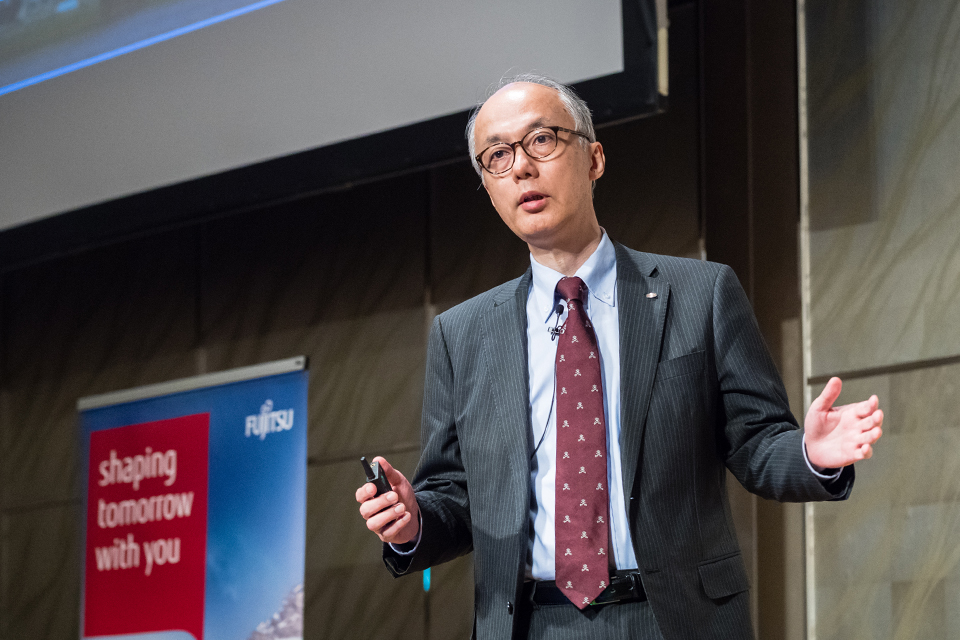
According to a global survey conducted by Fujitsu last February, 67% of the business leaders said their companies had started digital journeys and 20% to 30% of those projects had already produced positive business outcomes. The financial industry was the most progressive. A very important finding was why businesses had decided to embark on digital transformation. The survey revealed that business leaders aimed to use digital to grow the top line, in addition to just improving the efficiency. Moreover, another big agenda was to respond to threats posed by new digital business models. The biggest threat may be disruptions by digital platforms. Most well-known platforms are so-called GAFA (Google, Apple, Facebook and Amazon).
There are three levels in the digital transformation: digitalization of operations, digitalization of products and services, and development of a digital business model. The last level is of course the most powerful. Take the banking industry as an example. Banks realized the fact that 73% of the millennial generation were willing to use banking services provided by GAFA. In response to this clear threat, banks are accelerating to automate operations using AI and RPA, to deliver DIY (Do It Yourself) mobile banking, as well as to offer various Fintech products and services. Ultimately, banks are looking to a new business model. They are working to build an ecosystem with external players in adjacent industries, such as real estate companies, to offer engagement banking services tailored to the everyday-life needs of each customer.
'Taking No Risk is Itself a Big Risk'
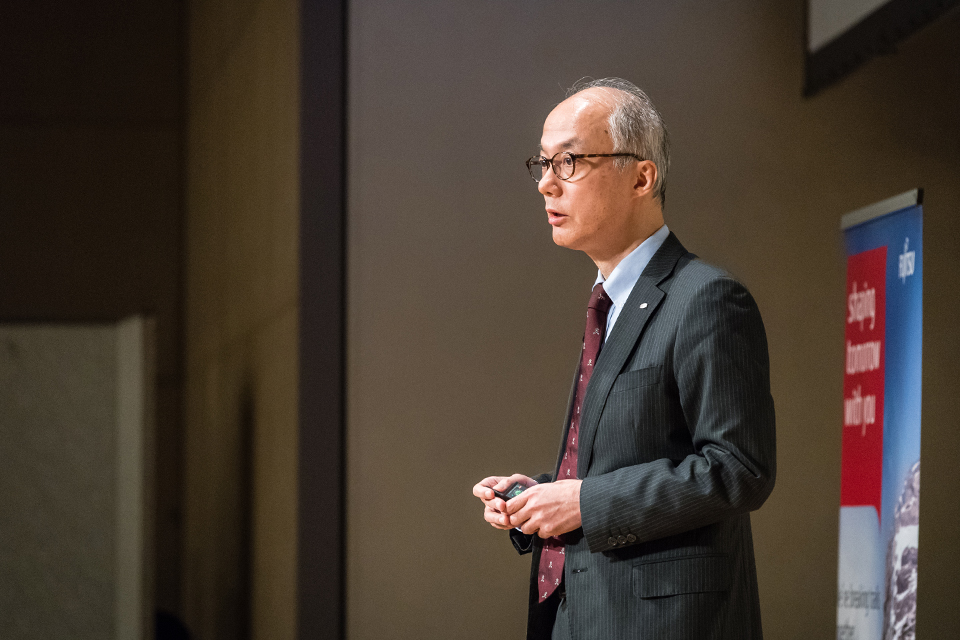
In this age of significant uncertainty, when the pace of change is very fast, taking no risk is itself a big risk. Even if digital transformation may conflict with their core businesses, companies need to take managed risks and try disruptive digital technologies at least in a small scale first.
A big challenge is how companies will shift from their historical closed vertical business model to an open and scalable business model. It is increasingly important to think about building an open B2B digital platform, focusing on data and the "job" that Professor McGrath explained about. Klöckner's XOM METALS platform, which is open to their competitors, is a good example.
Other examples include the logistics giant DHL, which launched Saloodo!, an open digital platform for logistics companies that include DHL's competitors. This platform is growing rapidly, connecting over 6,000 carriers and mobilizing 250,000 trucks. This platform helped DHL to capture a variety of small-scale long-tail shipping needs. So what's common to all of these examples is that they took managed risks and launched open B2B digital business platforms, independently from their existing core businesses.
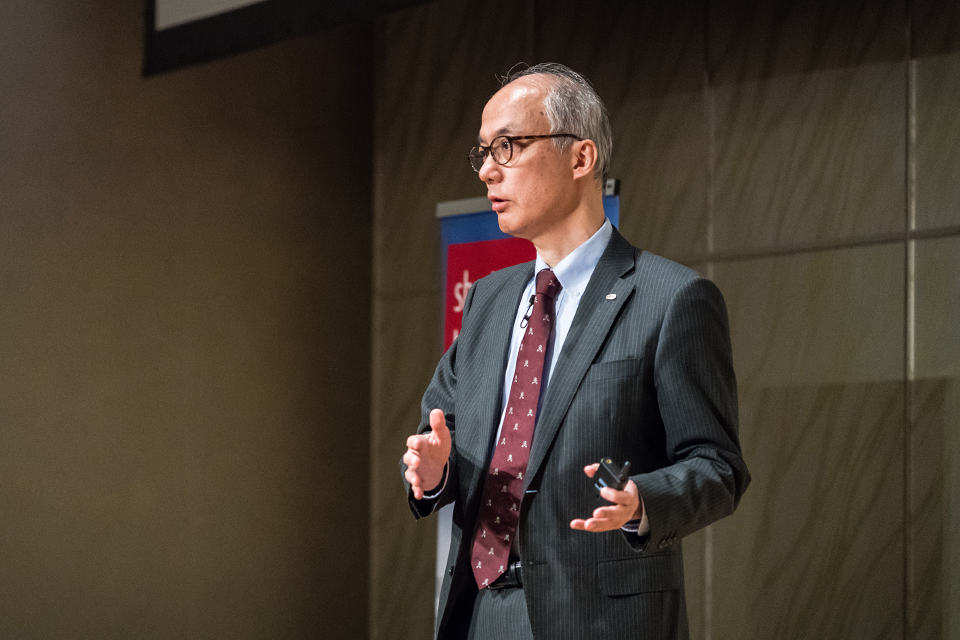
Lastly, I want to emphasize that it is people who drive innovation. While the analytical power of AI is rising, businesses are increasingly demanding the creativity, empathy and problem-solving capability that can be provided by people only. Business leaders need to think about building a human-centric organization leveraging these capabilities.
As a co-creation partner in the digital age, Fujitsu is committed to delivering your business success, through working together to help you design a digital vision and strategy, grow talent for digital transformation, develop agilely, drive open innovation and create value from data.
Eccentric Leadership Needed
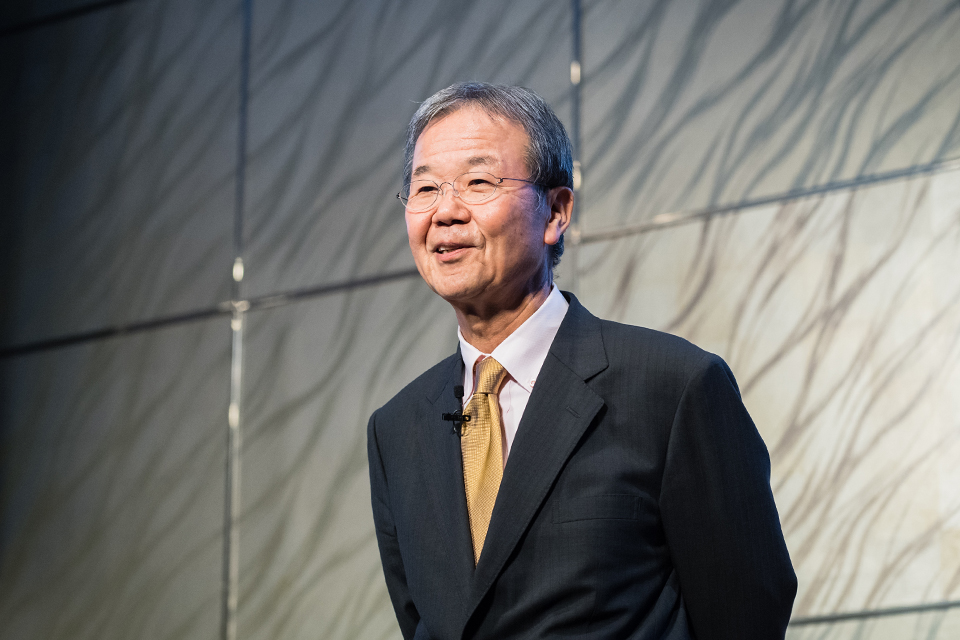 Yuzo Toda
Yuzo Toda
Companies must embark on transforming themselves if they are to address the far-reaching changes brought by digital disruption.
After the peak in 2000, the traditional film market declined rapidly. So we at Fujifilm learned an important lesson that the assumption of decline must be seriously discussed while the business was still profitable.
We set up a small team of 20 people and targeted to create a new business in the drug discovery and regenerative medicine. When you try to start a new business, you will face many challenges. Most of your initiatives will fail. But you can manage to make a success, through redefining your capability and tenaciously encouraging people with a narrative to achieve the goal. To do so, you have to abstract your capability and crystalize core principles.
At that time, you also realize the importance of your company's "tacit knowledge." Tacit, or unwritten, knowledge is not something that you can document or patent, but it is crucial. Business leaders must understand the value of tacit knowledge.
You are also required to have a strong passion and a sense of mission as well as a well-defined strategy. Without these, a new business does not fly. It is the leader's understanding of the central issue and his sense of mission that convince others and move them.
Deepening Knowledge and Getting in First
Referring to the problem of the vertical-integration model, we can see that successful global companies, such as Amazon and Google, have a very powerful, horizontal platform of their own. Uber is another example of a platform provider that has radically shaken up the market with their ride share service. Today, businesses with the traditional vertical-integration model find it difficult to meet customers' expectations.
In this context, it looks like many Japanese companies hesitate to take the next step, wondering what will happen to their existing business and how they can create value out of their business. Anxiety and a sense of urgency seem to occupy their minds.
In order to overcome this situation, you have to sharpen your company's knowledge and convert it into your business strengths. In other words, you have to deepen your knowledge and take action before everybody else does. Collaboration is required here. You need to transform the market, working together with your competitors.
Leaders Encouraged to Be "Crazy"
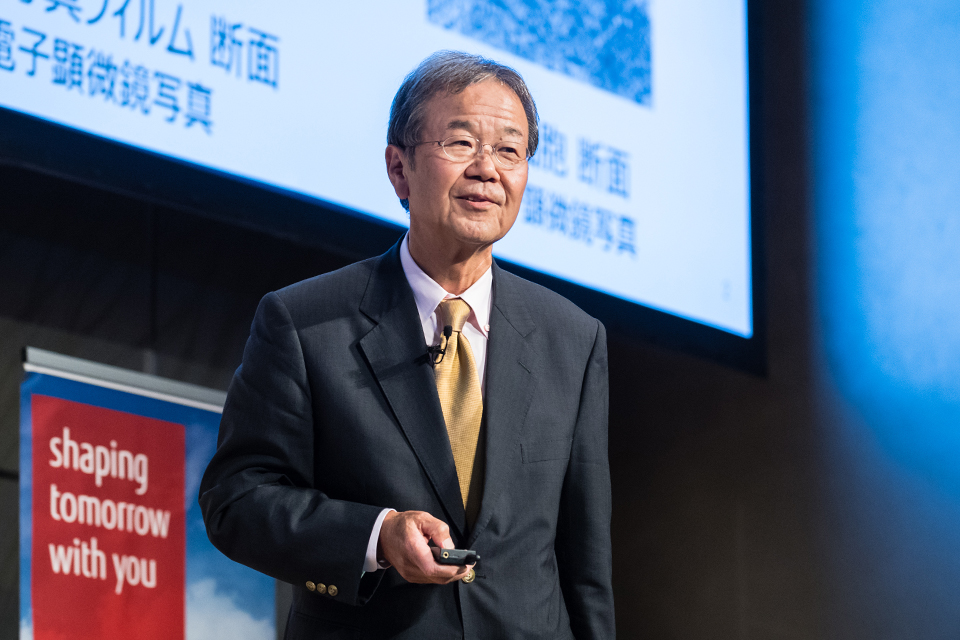
You also need a business leader with a strong mindset.
Leaders are those who are "crazy," and you need "fools" to support the "crazy" leader.
When you try to start something completely new, you realize there is a huge gap between the current state and the world you want to achieve. Common sense does not help. The one who dares to venture into such an impossible challenge may be viewed as a "crazy" leader. He needs the courage to deny himself and willingness to disrupt the existing norms. He also needs a strong mental power - the more opponents he encounters, the stronger he becomes. And here, you have supporters of his extraordinary ideas, that is, "fools." They are "fools" because they are willing to support the crazy initiative.
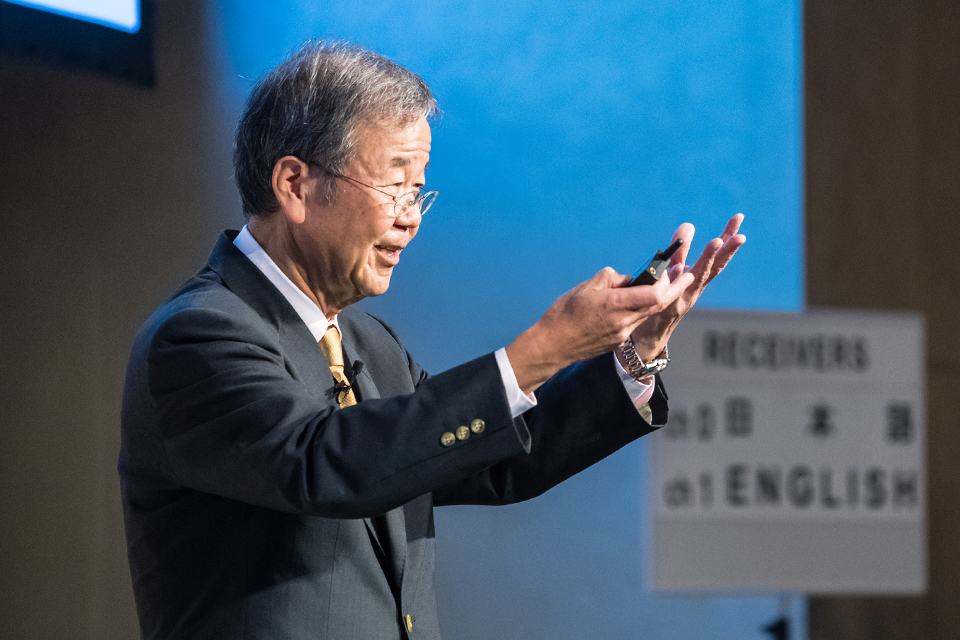
But we may say, it is a very good time today for you to be able to convince your colleagues and managers to accept your unusual idea.
No other time has ever been better than today. Using the power of big data and deep learning, any extraordinary hypotheses can be tested out to prove their validity. This way, you can quickly turn your idea into value and greatly improve productivity of innovation.
Leaders must be the game changers. So you must take offense. I believe, "defense is instinctive; offense requires talent." Defense is a job for anyone. In Japanese companies, most people tend to go on defense and build too many checkpoints. Very few dare to try passing through those gates to get to a goal. But I believe there are a lot of different ways to go through them. You can go through your own way. I encountered a lot of people resisting to my way of starting the new business. But I was able to carry the ball to the goal anyway. Through this difficult process, I felt like understanding each other at a deeper level. Be crazy and go on offense. That is my theory.
Watch the video to find out the key points of "New Business Development and Business Transformation" from Mr. Toda.
Panel Discussion
Formulating Business Strategy to Deal with Disruption
How can business leaders identify and cope with inflection points in their industries before it's too late? And how can companies balance the need to build new business with the desire to maintain core business operations? To wrap up the forum, Professor McGrath and Mr. Toda discussed the changing face of leadership and business strategy in the digital era, with Mr. Takashige as moderator.
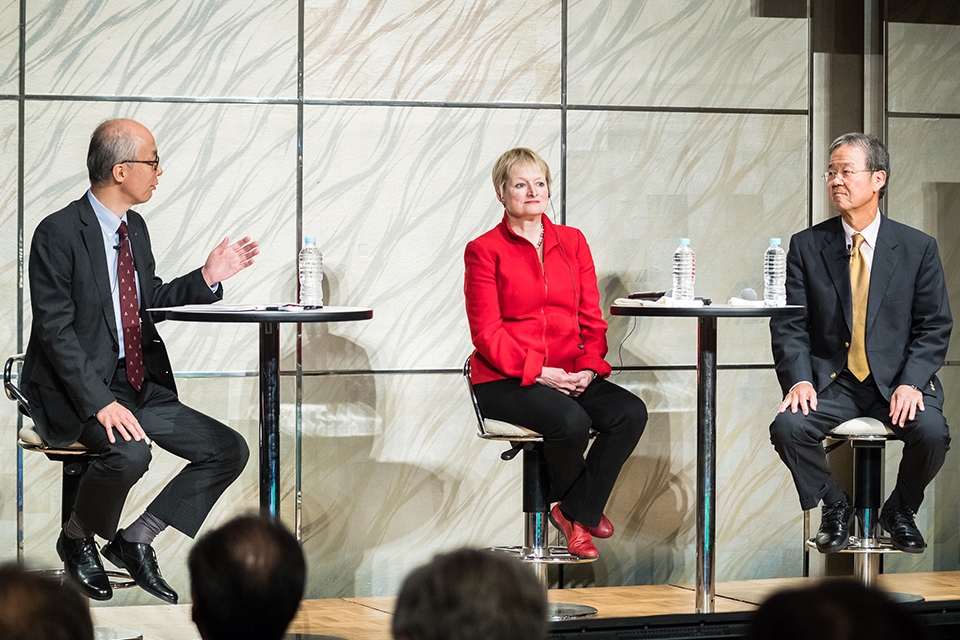
Yoshikuni Takashige
To design this forum, I asked myself what should be a fundamental question to address. That is how "Japanese people" can rebuild global competitiveness in the digital era, after the so-called lost two decades of the Japanese economy. Although it is very important to think about what corporate strategy is necessary, I like to discuss more on how we can change the behavior of people and what type of leadership is required today. Let's start with the inflection point. Professor McGrath told us that it is a point where conventional constraints of business no longer work. I'm interested in decision-making factors that help us prepare for it to avoid being too late. Can you share your view, Mr. Toda?
Yuzo Toda
Well, Japanese companies tend to value team players who work well with others in harmony. So that we do not fall behind, however, we need more diversity. I mean, we need individuals that stand out and generate unique value. Otherwise, organizations will be trapped in the defensive style and decline in the end. This will make the situation too late to react.
Rita McGrath
What I would observe in many of Japanese companies I worked with, there's a reluctance almost to be candid about new data: information coming in that isn't maybe consistent with the norm versus, say, more innovative firms where divergent opinions are sought out. Let me give an example from the development of Amazon Web Services. A guy named Benjamin Black built this scalable computing infrastructure to process Amazon's e-commerce activity. And then he and one of his colleagues had this insight: "Perhaps other companies have the same problem in scaling their own technology infrastructures." There's not a heavy corporate process at Amazon. What these two guys did was put together a two-page plan, written out on white paper. No PowerPoint. Then, they brought it to Jeff Bezos and said, "At the beginning, we don't need too much." Bezos loved their idea and sent them to Florida. So, he made a physical separation between the team and Amazon's headquarters, which is in Seattle, to develop the idea. New business opportunities come into being this way: A senior executive listens to a team with an innovative idea and lets them have the freedom to develop the idea.
Yoshikuni Takashige
What interests me here is Amazon's internal rules. They make a business decision based on a brief written plan, called a "narrative." No PowerPoint slides are allowed. Toda-san also emphasized that a leader needs a narrative. PowerPoint slides can deliver key points while hiding many details between the bullet points. But a narrative does not allow it. It is an interesting way to share an idea and make a decision.
Yuzo Toda
I believe companies today must become an incubator of talent for their employees. It's a company's important role to help each employee develop their skills and talents through their tasks. In the era of digital revolution, when a range of industries are facing disruptive changes, no company can survive competition with employees who have been committed only to traditional business and existing tasks. It has become a corporate mission to develop human asset who are able to start a new business for the future. I see Amazon doing it.
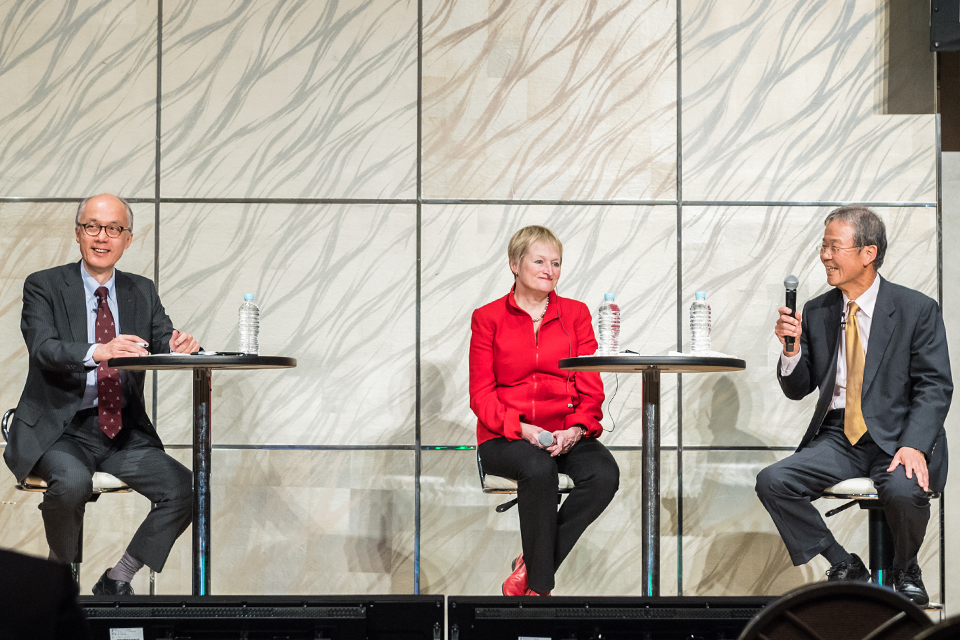
Yoshikuni Takashige
What kind of leadership is necessary for the companies to overcome the challenge of the digital inflection point? Toda-san, you mentioned you had to fight against resistance when you drove transformation.
Yuzo Toda
Though it may not be true for all the companies, I believe we need an optimistic leader who can transform resistance into energy. Also, the leader must carefully choose words for his narrative. No matter how short his words are, they must have the power to inspire and move people. The most important thing is the motivation of his team members, rather than the analysis of the market. Without building a trusted relationship with your people who share your vision and are fully committed to driving it together, you cannot make a meaningful change in the organization.
Rita McGrath
My own research suggests that we need at least three different kinds of leaders to have entrepreneurial efforts succeed: the executive champion, who directs the key strategy; the person to build the business with passion and energy; and in between, the kind of middle-management Sherpa person. If you wanted to climb Mount Everest, you wouldn't do it without the guidance of a Sherpa. The Sherpa is going to be the one that says, "Oh, you know, if the weather looks like this, we need to take this approach. Or if it looks as though it's going to snow, we need to wait." In other words, someone who deeply understands the organization, understands how to take the doubters and the resisters and persuade them.
Yuzo Toda
I think the Sherpa becomes the next leader. He knows the business thoroughly. A leader without hands-on experience of the business will just waste a lot of money and resources, and run the company down.
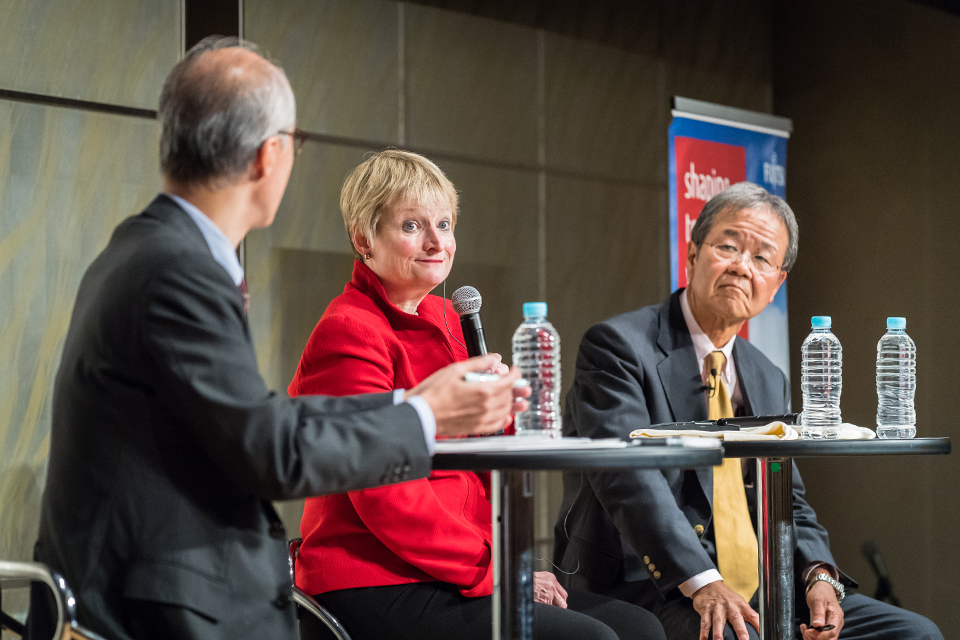
Yoshikuni Takashige
When a company starts up a digital business, facing disruptive changes in the market, there are potential conflicts between their core business and new business. What's the best way to manage through it?
Rita McGrath
Your core business can't stay the way it is. So to some extent, your core business is going to be changing. But that's a different kind of change than the change that's needed to create a new business. So I think the first criteria for success is to separate out who's doing the transformation in the core business, and who is leading the charge to build new business strings. Now what I think is interesting to both of those is that there's what some people call capability connection. So in the case of Fujifilm, it's their expertise in precision chemistry. A start-up doesn't have these deep capabilities that allow them to connect strength in the core business to new business in order to achieve digital transformation.
And I like to look at things in terms of portfolios. So there are some investments you are going to make to keep your core healthy. There are some investments that are the next-generation core. Then you have your investments in what I call options. An option is a small investment you make today that buys you the right but not the obligation to make a bigger investment in the future. And it's a very intuitive idea. Different kinds of businesses have different requirements, and they'll be changing at a different pace. So be clear about that as you're developing the strategy for the future.
Yuzo Toda
Although I agree with Professor McGrath on this point, that kind of portfolio management is not working well at many Japanese companies, due to the conflict between business divisions. A profitable business division should provide new business divisions with a fund for investment. It is an important role of the top management to make this happen, just as we see at Klöckner. They have the CEO's strong leadership.
Yoshikuni Takashige
Do you have any suggestion for businesses to manage their portfolio in order to protect seeds of innovation from being killed?
Rita McGrath
Absolutely. With any portfolio, you've got two sides: the investment side and the revenue side. In order to manage the portfolio, companies need to connect four business processes. The first is your strategy. Strategy is set from a viewpoint of the future, and it pulls you into the future. The second process is your budgeting process, which Mr. Toda just alluded to. Budgeting pulls you backward. This year's budget starts with last years' budget. So the two inherently are in tension. The third is the process by which projects get approved and map them on the business portfolio. And the fourth process is the reward process for people. So I think the job of managing innovation is getting a view of the portfolio and then ruthlessly making sure those four things connect for total optimization. Because what will happen if you don't manage it is that people will do what they think is best for themselves or their own piece of the business, and you won't have this transfer of resources from a business that's mature to businesses that are new.
Many may think as though innovation is something like a mysterious thing and a job for creative people with black t-shirts. But, in fact, it's a real process that you can learn, and it can be implemented. Only the tools and metrics are different. The decision making is different than you would make in the core business.
Yoshikuni Takashige
Today, the business environment is changing so rapidly. Business models must be transformed at the same pace. Fujitsu, for example, has shifted the focus of our core business from telecommunication systems to computers, and then IT services to cloud services. Currently, we are committed to new fields of business, including AI, blockchain and quantum computing. On the other hand, spiritual foundations of the company, such as a deep belief in the possibility of technology, a culture to value "reliability and creativity," executive messages of, "Just try it" and "Make dreams come true" remain intact to drive people to the next challenges. My questions here are: What is the strength of a company that lasts for a long time, unchanged? What part is the lasting core and what part are variables in your view?
Yuzo Toda
It's a tough question. The first thing I'd like to point out is the culture of the organization. Regardless of the change that is taking place around you, there is a core set of cultural principles you should keep. When I was a young employee at Fujifilm, a few years older colleague asked me if I knew what our company was making. I answered, "was that the photographic film?" Then, he said, "That's a silly answer. We are making trust." It was our core culture at that time, but it could evolve over time. So you have to continue to ask yourself, what is the core of the organization? It's important to have a mechanism that encourages middle leaders to continuously ask the question by themselves.
Rita McGrath
I did research about firms that achieved growth for 10 years in a row. So the rule was you had to increase your revenue by at least 5% over 10 years. That's a very tough bar, especially since the study period included 2008 with the Great Recession. And what I learned was that the growth outliers did two seemingly contradictory things. On the one hand, they kept a number of elements of their business model very stable: culture, values, core leadership messages and their network -- a very dense network that lasted for a long time. Even their strategies didn't change a lot over that period. But at the same time, they included a tremendous amount of dynamism. So what was dynamic? Budgets, experimentation with markets, the ability to move people around.
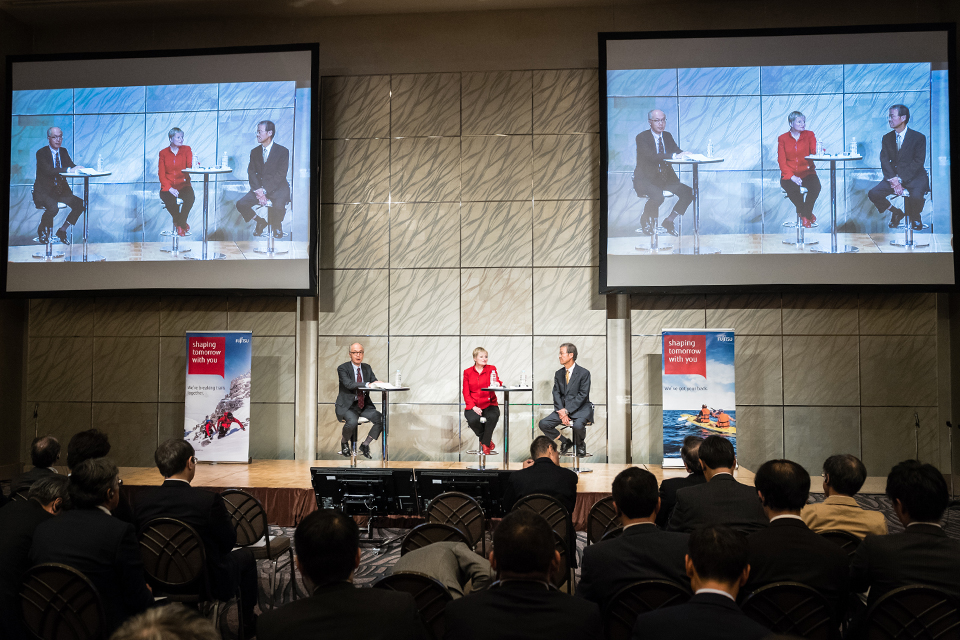
Yoshikuni Takashige
Japanese industries have experienced the so-called lost two decades. In order for Japan to enhance its global presence, what is the required strategy?
Yuzo Toda
Looking at Japanese organizations recently, I see them wasting their talent. Organizational rules have become too absolute for employees to have flexibility to realize their potential. So it feels like a small bento box that is fully packed with sushi. This has to change. Otherwise, we won't be able to catch up with the dynamism of the changing business environment. The "box" (organization) should be tailored to the talent and not the other way around.
Rita McGrath
Innovation and conformity are not necessarily helpful to one another. So if you talk about the crazy people or you talk about people that are different, if there's no place for them to go and be, it's very difficult to get the benefit of their talent. So I would be inclined to say, if you really want to end the 20 years of decline, you need to get to the structure of incentives. Are we offering incentives that create productive entrepreneurship? Or are the incentives in our companies perhaps unintentionally squashing it and saying, no, you're not going to be rewarded if you take a somewhat different approach?
Yoshikuni Takashige
My message that we have to make a shift from organization-centric to human-centric fully agrees with what Mr. Toda just noted. And Professor McGrath suggested that we build the structure of incentives in order to take advantage of the talents of people in our organization when we try to compete with global digital platformers. Lastly, could you please give the audience your advice for building their business strategies?
Watch the video to find out the key points of Panel Discussion "Digital Business Strategy".
Yuzo Toda
Especially as a leader, do not do things that others can do. When you define challenges and set out goals, you have to give full play to your unique personal quality. That is the mission of a leader. It must be a "goal first", not a "consensus first". You need to arrive at a consensus after you have set a goal.
Rita McGrath
Innovation and growth don't have to be a mystery. We have a very well-developed toolkit for step by step how you go about building innovation capabilities. So my encouragement would be to, first of all, get educated about what that looks like, because there's a lot of great material out there you can learn from. And then start small. Start with a couple of early experiments that you can use to prove the concept that'll help build confidence, then take that next step and go forward.
Yoshikuni Takashige
Thank you. With Professor McGrath and Toda-san, we have woven discussions that were very interesting to me. I hope the discussions will provide valuable insights for your future strategies. I thank you for taking time to attend the Fujitsu Executive Forum.




